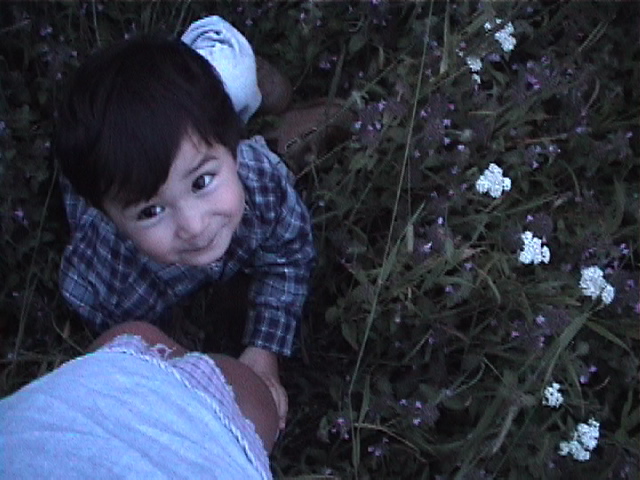[ An Audio version of this post. Music by my brother, John Oyzon and narration by me.]
Tonight was the annual Cobblestone picnic- a school that Aidan goes to. (Connor starts next year).
At the picnic, it’s all about the kids. I watch them take off on their own trajectories. Toddle after the baby. Sit quietly for the most part and observe the goings on. No desire to engage in conversation beyond my husband and the boys. (Too much work. Too hard to be interesting.) It’s comfortable to let it all play out –See how Gabriel tests the tensile strength of a blade of grass or tastes a dandelion stem.\n\nI am the invisible woman. The larger world is the focus. Things around and beyond me are the subject.
Later there is the return home, putting the boys to bed and picking up around the house, quiet except for the sound of the dishwasher. The sound of Jim trying to keep the boys at their nightly ablutions. Then his voice as he reads them a story.
I prepare for bed. Take off my clothes and see a brown girl- not old or young. I brush my hair. The reflection holds a good face, not beautiful, the beginnings of very fine lines that show one who smiles a lot. The history of three pregnancies is written in stretch marks, a long scar and skin like a deflated balloon. Flannel pants and a T-shirt. Time for the boys’ lullabye.
This is my life. A supporting player, not the star.
The woman on stage, the one who lectures, the one who works the audience, is a persona that I call upon. She is another face that is dredged to the surface with effort and leaves me exhausted when she’s through.
Being an invisible woman is comfortable. To be unflappable and calm, quiet and strong- all good. But apparently she is an illusion. Once people have seen the other- the persona. Once she has spoken her mind, then they have seen inside mine. In that moment on stage, the indsides are broadcast, and even later, when quiet, they know that underneath, something stirs.
The other persona is scary. She’s passionate, and lively, confident in her voice and body and wants more from life than the invisible one, the calm one who believes life is good just the way it is. There is fissure here. Hairline cracks in a perfect life.
Comments:
Liz – This entry needs a picture, I think. And for what it’s worth, I think you’re beautiful and funny. 🙂
nain’, ‘eomast@hotmail.com’ – ‘2004-05-16 20:41:17 – Maybe all people think like this. We’re more alike than i thought. It’s like we could be sisters!
Weez, ero@it.rtit.edu’, 2004-05-16 20:41:17 – But we are…I always thought you were more visible than not. You play well with others.
Cath’, ‘cii@it.rit.edu’, ”, ‘2004-05-16 20:41:17 – Sounds rather “Eleanor Rigby-ish. Sounds like my life in part. I find the teaching persona enthralling. But also quite tiring. I yearn to be more fluid and graceful and alluring. And secretly I am. the scary aspect is, “what happens to the old if you become the new…?” How schizophrenic of me!!
Francois Lachance’, ‘lachance@chass.utoronto.ca’, ‘http://www.chass.utoronto.ca/~lachance/jardin/html/blogTEI.htm’, ‘2004-05-16 20:41:17’, ‘Continuing the folding and lacing (and learning to inscribe the “oyzon” part of the url (see https://weez.oyzon.com/archives/000003.html) Folding the March 29, 2004 entry entitled IN AND OUT with the June 6, 2003 entry entitled HAIRLINE CRACKS and wondering about the coming into invisilibity and the control of breath and audibility. It’s a knack moms (and others) have of being heard even when they appear to say nothing. There is a marvelous play at work on the “indside” — inside the id-side — work with the perfect crack. A symphony for the eye. \n\nLeonard Koren “Exquiste decay” Utne Reader Sept-Oct 2001 p. 52 ff explains how wabi-sabi restores a measure of sanity to modern living. From the culture of Japan, wabi-sabi incorporates lessons such as “all things are impermanent”, “all things are imperfect” and “all things are incomplete”. Does one ever finish being a teacher? I have difficulty understanding seeing inside someone’s mind. I can understand a seeing with what the other person brings to the moment. There pershaps four positions: being heard, being seen, being seen and heard and neither being seen nor heard. Take a second square of options and you are able to trace the dances that people enact in their lived relations. A child and a mother play lots of peek-a-boo games, lots of games of silence (in the sense of the Chippewa game where the poet attempts to break an audience’s silence by laughter or any similarly loud response. See Jerome Rothenberg Poems for the Game of Silence) For “mother” read “parent”, “older sibling” or “teacher”. For “child” read “teacher”.


Pingback: » time passages weezBlog